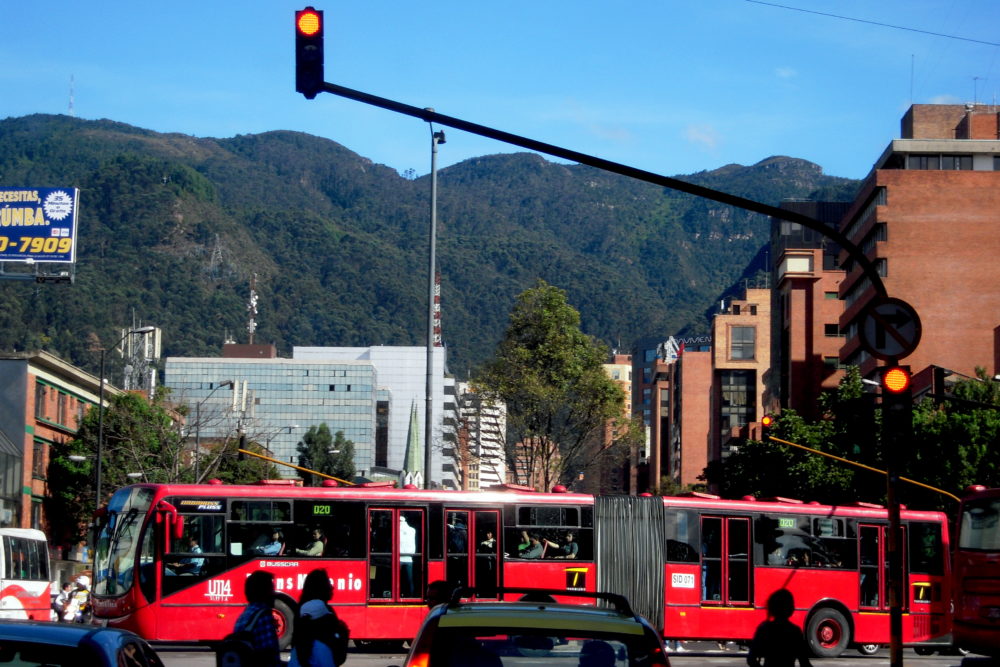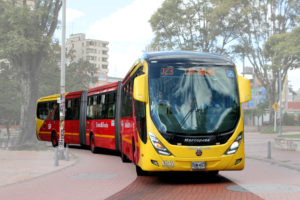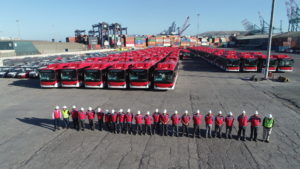Once a global symbol of sustainable public transport, Bogotá last week banished the idea of electric buses.
Instead, TransMilenio, the city’s almost twenty year-old public transport system, bet on diesel and natural gas busses. The electric power boom led by Chinese manufacturers seemingly still has to overcome economic and technological barriers – and change perceptions – if it is to become an attractive option in Latin America metropolises.
At the same time, pollution and air quality have become increasingly sensitive political issues for Latin America’s urban citizens.
Bogota’s decision
Last Friday, Bogotá announced the companies that won the tender to renew the fleet of 1,160 TransMilenio busses that will operate over the next decade.
In the midst of great expectation and political tension, the bus rapid transit system (BRT) chose two diesel and three gas operators as the winners of a tender that the city had postponed for more than seven years. Estructura Plural and Bogotá Móvil Provisión won the contract to supply the diesel busses, all of which are manufactured by Swedish company Volvo.
Despite pressure from many sectors, none of the busses that will operate from January 2019 will be electric. Chinese company BYD – the only electric option – saw its part of the tender, for 260 busses, deemed unsatisfactory.
The news caused controversy in political circles, with many insisting it is not justifiable for Bogotá to opt for technologies based on fossil fuels instead of clean ones.
“To think that going from diesel to a different diesel or gas is a great step forward, when there are options for electric busses, shows huge intellectual and political blindness,” said former vice presidential candidate Claudia López.
Right-wing senator Rodrigo Lara said: “It’s very serious news for our children and grandparents who will continue to get sick with the particulate material the busses emit.”
The issue became the centre of a bitter political debate in a city whose population went from being enormously satisfied with how an innovative public transport system decongested the city, to one that punished it years later when it proved unable to handle the demands of its 8 million inhabitants.

This swing in public opinion mirrored approval rates for current mayor Enrique Peñalosa, considered a pioneer when he established TransMilenio in his first term 18 years ago and became the visible face of the BRT worldwide, but who today is very unpopular.
Anger has grown at poor air quality in the past two years as Bogotá’s citizens worry increasingly about a significant increase in respiratory diseases.
Many citizen groups began to push for the rapid adoption of technologies that emit less greenhouse gases than conventional busses powered by diesel.
Doing so would be a double win for Colombia. Firstly, as in other countries in the region, the transport sector contributes significant emissions that cause climate change. Urban public transport accounts for 15% of these, behind only cargo trucks and almost the same as private vehicles.
In its commitments under the Paris Agreement, Colombia considered replacing 75% of public busses in Bogotá, Medellin and five other cities with zero-emission vehicles by 2040. Colombia is responsible for just 0.37% of global emissions, yet it is one of the countries most vulnerable to the effects of climate change and has been studiously planning how to tackle reduce them.
Secondly, electric technology has an additional appeal for Colombia given that 70% of electricity comes from hydroelectric power plants. The country has a much cleaner energy supply than most countries and, therefore, the busses would be even greener.
However, criteria other than air quality prevailed in Bogotá’s tender. The city opted to ensure a greater load capacity of the busses and a better quality of service. For this, both natural gas (which has advanced greatly in the last decade) and diesel worked well.
The city even argued that moving from diesel engines certified with the Euro II and III standard – like those the TransMilenio has been using since 2000 – to the newer Euro V ones would reduce the particulate matter emissions by 80%.
No State, no electric vehicles
The introduction of electric vehicles is, however, more complex. The Bogotá tender made it clear that there are several important obstacles for the technology – driven globally by China – to go mainstream in Colombia and other Latin American countries.
Firstly, there is a big economic obstacle to easily emulating the models espoused by the Chinese city of Shenzhen, whose fleet of 16 thousand busses is entirely electric.
“When you analyse the experience of Shenzhen, you realise that behind it there is a robust public policy, both provincial and national, including support for the purchase of busses. There is full support that makes it feasible,” explained Darío Hidalgo, a Colombian engineer who heads the World Resources Institute’s Ross Center for Sustainable Cities.
Moreover, an electric bus can cost twice that of a diesel one, not to mention the infrastructure needed to recharge batteries. Although this cost has been decreasing and battery life has increased, it continues to be an obstacle in places like Colombia (and a good part of Latin America) where private companies assume all the operational risks.
For transport experts, it was ironic that former environment minister Luis Gilberto Murillo, wrote to Bogotá’s Mayor Enrique Peñalosa asking him to prioritise zero-emission technologies but without accompanying his complaint with any governmental initiative to make new technologies accessible to all. Beyond a reduction on import tariffs and an exemption from consumption tax, the Colombian State has done little to promote them.
“The real public policy is the one that puts instruments in place to help the city achieve it,” says Hidalgo, who was deputy manager of TransMilenio in its first four years of operation.
A recent report on the electric car market by US think-tank The Dialogue, which considered eight cities including Bogotá, made a similar point.
Did you know…
There are now 370,000 electric busses in the world – 99% are in China.
“The absence of specialised financial instruments or business models to incentivise electric vehicles has slowed down their use,” lead researcher Guy Edwards concluded. There are now 370,000 electric busses in the world – 99% are in China.
Chile’s capital Santiago does have a scheme and will debut 100 electric busses this year thanks to an alliance between BYD and the Italian energy company Enel. Paradoxically, Enel also operates Bogotá’s electricity but has not supported a similar model.
Ecaudorean capital Quito and Mexico City have promised not to buy any public transport vehicles powered by fossil fuels after 2025.
In June, six manufacturers sent a letter to the Bogotá administration requesting that it guarantee a 30% quota for electric busses. This, they argued, would incentivise the industry.
Although the idea was not accepted, they managed to modify some conditions and learn more about greener technology. Five of the companies are Chinese (BYD, Yutong, Shanghai Sunwin, Foton and Zhongtong / Yinlong / DongFeng / Sinotruck), only one ended up participating.
A cutting-edge but uncertain technology
A second obstacle for electric busses is the little experience that transport companies have with the technology. Many do not yet have trained personnel or adequate infrastructure (for example, battery charging). It also isn’t clear whether Chinese manufacturers can provide technical or maintenance services.
Additionally, experiments with electric prototypes in Bogotá showed that there are still many practical issues to be solved for vehicle parts like automatic doors. This is because there is an existing market for ordinary electric busses, but not yet articulated and bi-articulated, as required by a BRT system (created by Curitiba in Brazil and scaled-up by Bogotá).
Many operators feel that European and American manufacturers are investing not only in research and development, but also in launching products on the market that have proven records. In their view, many Chinese manufacturers are still developing. This problem of perception, real or not, has obstructed the expansion of electric busses.
“The world is changing to clean energy, but to go 100% would imply an important operational risk, because all the uncertainties come at a cost,” said Luis Ángel Guzmán, a professor of transportation at the Universidad de los Andes in Bogotá.
He added: “At the same time, we don’t have to wait for another tender in 10 years. You can think about introducing electric vehicles gradually, as has been done with hybrids, and test them out little by little. We can go on learning.”








